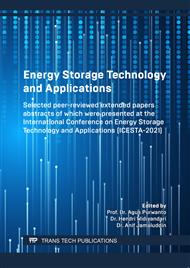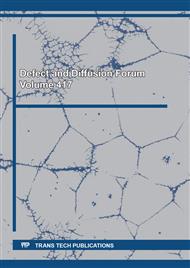[1]
S. Chu, Y. Cui, and N. Liu, The path towards sustainable energy,, Nat. Mater., vol. 16, no. 1, p.16–22, 2016,.
Google Scholar
[2]
F. Pu, C. Kong, J. Lv, W. Zhang, and X. Zhang, CuO ultrathin nanosheets decorated reduced graphene oxide as a high-performance anode for lithium-ion batteries,, J. Alloys Compd., vol. 805, p.355–362, 2019,.
DOI: 10.1016/j.jallcom.2019.06.160
Google Scholar
[3]
J. B. Goodenough and K. S. Park, The Li-ion rechargeable battery: A perspective,, J. Am. Chem. Soc., vol. 135, no. 4, p.1167–1176, 2013,.
DOI: 10.1021/ja3091438
Google Scholar
[4]
H. Bin Wu, J. S. Chen, H. H. Hng, and X. W. Lou, Nanostructured metal oxide-based materials as advanced anodes for lithium-ion batteries,, Nanoscale, vol. 4, no. 8, p.2526–2542, 2012,.
DOI: 10.1039/c2nr11966h
Google Scholar
[5]
H. S. H. Mohamed, C. Li, L. Wu, W. Shi, and W. Dong, Growing ordered CuO nanorods on 2D Cu/g-C3N4 nanosheets as stable freestanding anode for outstanding lithium storage,, no. August, 2020,.
DOI: 10.1016/j.cej.2020.126941
Google Scholar
[6]
Q. Wang, J. Zhao, W. Shan, X. Xia, L. Xing, and X. Xue, CuO nanorods/graphene nanocomposites for high-performance lithium-ion battery anodes,, J. Alloys Compd., vol. 590, p.424–427, 2014,.
DOI: 10.1016/j.jallcom.2013.12.083
Google Scholar
[7]
R. Dang, X. Jia, X. Liu, H. Ma, H. Gao, and G. Wang, Controlled synthesis of hierarchical Cu nanosheets @ CuO nanorods as high-performance anode material for lithium-ion batteries,, Nano Energy, vol. 33, p.427–435, 2017,.
DOI: 10.1016/j.nanoen.2017.01.024
Google Scholar
[8]
S. H. Lee, Y. Noh, Y. R. Jo, Y. Kim, B. J. Kim, and W. B. Kim, Carbon-Encapsulated SnO2 Core-Shell Nanowires Directly Grown on Reduced Graphene Oxide Sheets for High-Performance Li-Ion Battery Electrodes,, Energy Technol., vol. 6, no. 7, p.1255–1260, 2018,.
DOI: 10.1002/ente.201700804
Google Scholar
[9]
J. S. Park et al., Synthesis and Electrochemical Reaction of Tin Oxalate-Reduced Graphene Oxide Composite Anode for Rechargeable Lithium Batteries,, ACS Appl. Mater. Interfaces, vol. 9, no. 31, p.25941–25951, 2017,.
DOI: 10.1021/acsami.7b03325
Google Scholar
[10]
M. J. Aragón, B. León, T. Serrano, C. Pérez Vicente, and J. L. Tirado, Synergistic effects of transition metal substitution in conversion electrodes for lithium-ion batteries,, J. Mater. Chem., vol. 21, no. 27, p.10102–10107, 2011,.
DOI: 10.1039/c0jm03880f
Google Scholar
[11]
F. Nacimiento, R. Alcántara, and J. L. Tirado, Cobalt and tin oxalates and PAN mixture as a new electrode material for lithium ion batteries,, J. Electroanal. Chem., vol. 642, no. 2, p.143–149, 2010,.
DOI: 10.1016/j.jelechem.2010.02.033
Google Scholar
[12]
M. C. López, J. L. Tirado, and C. Pérez Vicente, Structural and comparative electrochemical study of M(II) oxalates, M = Mn, Fe, Co, Ni, Cu, Zn,, J. Power Sources, vol. 227, p.65–71, 2013,.
DOI: 10.1016/j.jpowsour.2012.08.100
Google Scholar
[13]
C. Xu, Y. Liu, G. Xu, and G. Wang, Preparation and characterization of CuO nanorods by thermal decomposition of CuC2O4 precursor,, Mater. Res. Bull., vol. 37, no. 14, p.2365–2372, 2002,.
DOI: 10.1016/s0025-5408(02)00848-6
Google Scholar
[14]
A. M. Donia, N. R. E. Radwan, and A. A. Atia, Preparation of mixed Co and Cu oxides via thermal decomposition of their oxalates, and study of their catalytic properties,, J. Therm. Anal. Calorim., vol. 61, no. 1, p.249–261, 2000,.
Google Scholar
[15]
B. Wang, X. L. Wu, C. Y. Shu, Y. G. Guo, and C. R. Wang, Synthesis of CuO/graphene nanocomposite as a high-performance anode material for lithium-ion batteries,, J. Mater. Chem., vol. 20, no. 47, p.10661–10664, 2010,.
DOI: 10.1039/c0jm01941k
Google Scholar
[16]
L. J. Xu, W. Chu, L. Gan, W. Chu, and L. Gan, Environmental application of graphene-based CoFe2O4 as an activator of peroxymonosulfate for the degradation of a plasticizer,, 2014,.
DOI: 10.1016/j.cej.2014.11.065
Google Scholar
[17]
A. Ramazani et al., A NOVEL GREEN SYNTHESIS OF COPPER OXIDE NANOPARTICLES USING A HENNA EXTRACT POWDER,, vol. 59, no. 7, p.1737–1743, 2018,.
DOI: 10.1134/s0022476618070302
Google Scholar
[18]
B. Indumathi, S. Thamizharasan, and J. Gopinathan, Electrically Conducting, Transparent, Graphene-Based Nanocomposite Coatings on Flexible Film Substrate 1,, 2016,.
DOI: 10.1134/s0965545x16050035
Google Scholar
[19]
W. Kang and Q. Shen, The shape-controlled synthesis and novel lithium storage mechanism of as-prepared CuC2O4·xH2O nanostructures,, J. Power Sources, vol. 238, p.203–209, 2013,.
DOI: 10.1016/j.jpowsour.2013.03.087
Google Scholar
[20]
A. N. Christensen, B. Lebech, N. H. Andersen, and J. C. Grivel, The crystal structure of paramagnetic copper(ii) oxalate (CuC2O4): Formation and thermal decomposition of randomly stacked anisotropic nano-sized crystallites,, Dalt. Trans., vol. 43, no. 44, p.16754–16768, 2014,.
DOI: 10.1039/c4dt01689k
Google Scholar
[21]
M. Rahimi-Nasrabadi, S. M. Pourmortazavi, A. A. Davoudi-Dehghani, S. S. Hajimirsadeghi, and M. M. Zahedi, Synthesis and characterization of copper oxalate and copper oxide nanoparticles by statistically optimized controlled precipitation and calcination of precursor,, CrystEngComm, vol. 15, no. 20, p.4077–4086, 2013,.
DOI: 10.1039/c3ce26930b
Google Scholar
[22]
J. V. Bellini, R. Machado, M. R. Morelli, and R. H. G. A. Kiminami, Thermal, Structural and Morphological Characterisation of Freeze-dried Copper(II) Acetate Monohydrate and its Solid Decomposition Products,, Mater. Res., vol. 5, no. 4, p.453–457, 2002,.
DOI: 10.1590/s1516-14392002000400010
Google Scholar
[23]
F. Behnoudnia and H. Dehghani, Copper(II) oxalate nanospheres and its usage in preparation of Cu(OH)2, Cu2O and CuO nanostructures: Synthesis and growth mechanism,, Polyhedron, vol. 56, p.102–108, 2013,.
DOI: 10.1016/j.poly.2013.03.051
Google Scholar
[24]
J. Światowska, V. Lair, C. Pereira-Nabais, G. Cote, P. Marcus, and A. Changes, XPS, XRD and SEM characterization of a thin ceria layer deposited onto graphite electrode for application in lithium-ion batteries,, Appl. Surf. Sci., vol. 257, no. 21, p.9110–9119, 2011,.
DOI: 10.1016/j.apsusc.2011.05.108
Google Scholar
[25]
A. A. Dubale, C. Pan, A. G. Tamirat, J. Lee, Y. Yang, and B. Hwang, Supporting Information photocathode for photoelectrochemical water reduction,, p.1–18, (2015).
Google Scholar
[26]
I. ul Haq and F. Haider, Synthesis and characterization of uniform fine particles of copper oxalate,, Mater. Lett., vol. 63, no. 27, p.2355–2357, 2009,.
DOI: 10.1016/j.matlet.2009.08.008
Google Scholar
[27]
N. Topnani, S. Kushwaha, and T. Athar, Wet Synthesis of Copper Oxide Nanopowder,, Int. J. Green Nanotechnol. Mater. Sci. Eng., vol. 1, no. 2, p.37–41, 2010,.
Google Scholar
[28]
L. I. Yudanova et al., Thermolysis of copper(II) salts of maleic acid. Synthesis of metal-polymer composites,, Russ. J. Coord. Chem. Khimiya, vol. 39, no. 5, p.415–420, 2013,.
DOI: 10.1134/s1070328413050102
Google Scholar
[29]
C. Ma, K. Yang, L. Wang, and X. Wang, Facile synthesis of reduced graphene oxide/Fe3O4 nanocomposite film,, J. Appl. Biomater. Funct. Mater., vol. 15, no. Suppl 1, pp. S1–S6, 2017,.
Google Scholar
[30]
T. E. Saraswati, D. Maharani, and H. Widiyandari, Copper oxide-based carbonaceous nanocomposites: Electrochemical synthesis and characterization,, AIP Conf. Proc., vol. 2243, no. June 2020,.
DOI: 10.1063/5.0001626
Google Scholar



